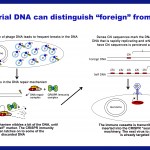CRISPR
Beagles (Hercules, left, and Tangou, right) genetically-modified to be more muscular. Image from Scientific American, Courtesy of Zou Qingjian and Lai Liangxue at the Guangzhou Institutes of Biomedicine and Health, Chinese Academy of Sciences.
Researchers in China are exploring the use of gene-editing technologies to create customized animals. Take for example research at the Shaanxi Provincial Engineering and Technology Research Center for Shaanbei Cashmere Goats where animals have been genetically-modified to have longer hair (i.e. more wool) and more muscles (i.e. meat).…
We've been fans of the Molecule of the Month series by David Goodsell, for many years. Not only is Dr. Goodsell a talented artist but he writes very clear descriptions of the ways molecules like proteins, RNA, and DNA work together and function inside a cell.
To learn about proteins and their activities, I like to go directly to the Molecule of the Month page, where I can find a list of articles organized by molecule type and name. Many of these articles can also be downloaded in a PDF format.
A really nice of his articles is that he includes PDB IDs for all the…
Foreigner or native-born? Your immune system discriminates between them, as do those of bacteria. Yes indeed, bacteria do have immune systems – pretty complex ones at that. And like any useful immune system, the bacterial ones must have a good technique for distinguishing “foreign” from “self.”
You may even have heard of the bacterial immune system: It’s called CRISPR, and it’s used in biology research around the world for DNA engineering and genome editing. CRISPR normally inserts short DNA sequences taken from phages – viruses that invade bacteria – into special slots called spacers within…

